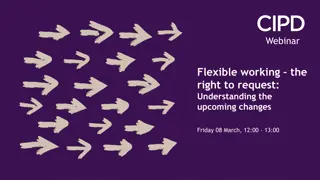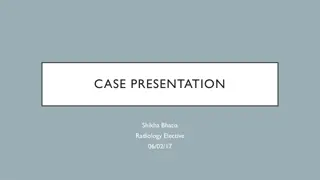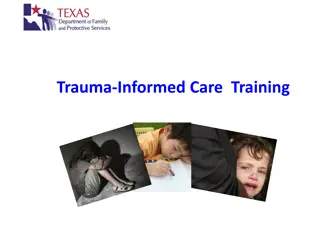
Trauma's Impact on Memory and Experience
Explore the intricate workings of memory, association, dissociation, sensations, emotions, and the profound effects of trauma on the integration of experiences. Uncover how traumatic events disrupt the brain's ability to process and associate memories, leading to dissociation and fragmented recollections.
Download Presentation

Please find below an Image/Link to download the presentation.
The content on the website is provided AS IS for your information and personal use only. It may not be sold, licensed, or shared on other websites without obtaining consent from the author. If you encounter any issues during the download, it is possible that the publisher has removed the file from their server.
You are allowed to download the files provided on this website for personal or commercial use, subject to the condition that they are used lawfully. All files are the property of their respective owners.
The content on the website is provided AS IS for your information and personal use only. It may not be sold, licensed, or shared on other websites without obtaining consent from the author.
E N D
Presentation Transcript
Working Through the Traumatic Memories of Mind-Controlled Clients and destroying the mind control
Basic Biology of Memory Association and Dissociation
Components of Any Experience When we experience something, we put together fragments of the experience from: the different senses and the various emotions (reactions to the sensations and the meaning we have made of these sensations). In normal life, these fragments are woven together in the hippocampus and sent as a whole experience to the cerebral cortex. We are generally unaware of the complexity of what we are experiencing. These fragments, put together, tell the story of what happened to us. Trauma causes dissociation, which keeps the fragments separate.
Sensations Eyes: what we see Ears: what we hear (including background noise) Nose: what we smell Mouth: what we taste Bodily sensations: generally located in specific parts of the body The softness or hardness or spikiness of what we touch or what touches us; Itches sexual feelings Pain (dull, sharp, prolonged, brief) Sensations of motion, balance, dizziness Drugged sensations
Emotions We interpret our sensations and emotions arise in response, in particular to the interpersonal situation. Sadness, loneliness, despair, nostalgia Boredom, excitement, exhaustion Anxiety, fear, horror Anger, fury, frustration, disgust Guilt, shame Comfort, serenity, joy, happiness, delight, amusement, awe Triumph, satisfaction Confusion, turmoil, awkwardness Sympathy, empathic pain, envy, pity, love, admiration A single experience can produce a variety of emotions.
Trauma Prevents Full Association of the Elements of Experience Especially in infancy and childhood, an overwhelming experience, particularly one with physical and emotional pain, cannot be fully put together. When the amygdala (the brain s alarm bell) shuts down the hippocampus because of overload, the fragments of the experience are never integrated. The brain circuit which entered this traumatic experience is replaced by new ones which hold different aspects of the experience. Insiders develop to hold particular types of fragments of experience. Each insider (part, alter) is (in my opinion) a separate brain circuit. Every feeling has certain insiders who have the job of holding that feeling.
The Biology of Memory Reconstitution A memory can be reconstituted if it is relived while the person knows he or she is in a safe place with a safe person. Or completely alone. The fragments of experience belonging to the different senses and emotions are brought together, and fed through the hippocampus to the cerebral cortex, where they become integrated. In this way the memory fragments move from the unconscious to the conscious mind. What was formerly a dissociated, forgotten memory is now consciously remembered. It no longer erupts in disturbing ways. It loses much of its emotional punch. And it begins to be less clear and can be contaminated by other contents of consciousness. When a memory is put together, some dissociative barriers are no longer necessary, and parts of the person involved in that memory often join together.
Resolving Traumas through Memory Processing At the time a memory is processed, it is as if it is experienced for the first time; it has not been contaminated because its components have been kept separate from one another and from other memories. A trauma is not resolved until all aspects of it have been joined: knowledge, sight, hearing, touch and taste, pain, drugs, and each emotion involved. Organized abuser groups know this, and put in programming to prevent memories being fully reconstituted. Reactivator parts are trained to take and withhold specific parts of important training memories. A memory usually involves several insider parts of the person (inner people), each of whom holds a particular feeling, sensory modality or piece of knowledge.
Importance of Memory Work with Organized Abuse Survivors If a survivor doesn t work through the memories, he or she remains fragmented and constantly fighting against impulses or feelings. Genuine integration of parts will not occur, though they may learn to cooperate. If a survivor gets the full story (sight and sound content) of the memory without the feelings, it may make it easier for the person (front parts) to be aware of the deceptions, and resist mind-controlled behaviors. But there is a risk of the feelings flooding the survivor because a partially completed memory struggles to complete itself. And without the emotions worked through, the rational parts of the person may continue to be unaware of the evil of what happened. The most effective method of freeing survivors from the mind control, fears and behavioral compulsions ( jobs ) assigned to parts is working through the memories of the training which created the mind control.
Deciding Whether & When to Pursue Memories Initially memories come up as punishment for disclosures, so it is unwise to try to work them through. The fact that memories (usually flashbacks of parts of memories) come up does not indicate the survivor is ready to work them through. If you try to work with memories early in the recovery process, the security system is triggered and parts do their jobs, such as punishing and reporting to perpetrators. Don t do memory work until those in charge of the system agree to it, or agree to certain relatively innocuous memories being worked on. This may (of course) still trigger parts to do their jobs. Don t do memory work during periods of current life stress for the survivor, as it can cause bodily and emotional symptoms when memories are only partially processed. A survivor should not work on several memories at once. Emotions may flood and memories may remain incomplete.
Dealing with Flashbacks A flashback is a memory fragment, a closed physiological loop of re- abuse, which can be Visual (hallucinations) Auditory (voices, screams) Emotional (panic, despair, shame) Physiological ( body memory , e.g. of rape or drugs or shock). Do not chase flashbacks. With mind control or ritual abuse survivors, most are deliberately sent as punishment. Use the memory storage ( files ) built in by the abusers and ask that those in charge of these files put the flashbacks away.
Closing down Flashbacks Non-programming memories can flash back on their own and the abusers memory storage system may not work for them. For flashbacks in the therapy session, use grounding: tell client to open their eyes, name things in the room, name the sounds they hear in the room, touch their clothing. Use a signal to bring client back to the present, e.g. right hand on their right shoulder with word Stop! If you know off triggers and the client knows how you know them, you can use them. Teach client to do grounding and off triggers when alone. Teach client internal negotiation (with the parts causing the flashback, not the ones experiencing it).
Beginning Memory Work At a certain point you can tell that those in charge of the system are letting some memories or parts come out and those are ready to be dealt with, and internal punishment for disclosure will be light. Then you can proceed cautiously. With regular abuse survivors, you wait for the memories to emerge and work with those that are emerging. With mind control survivors, you choose the memories strategically in order to dismantle the programming, beginning with safety issues. You do not need to know what the memory contains before you begin. Just something like The memory that makes you cut your arms, or The memory that makes you leave your window open. Mind controlling groups deliberately install storage systems for memories, particularly training memories. This storage records everything you need to know which parts (alters) are in a memory, when the event occurred, what it was training for, etc.
Choosing Memories to Work With There is already a filing system for memories, especially the ones that constitute programs. Use it! Begin with easy traumatic memories, minor traumas without too much shock or horror or physical pain, which are not part of the programming. Working through these more accessible memories allows the survivor to learn the process. Other parts can observe and see how it resolves the trauma of those parts involved in these memories. Then have the system choose memories on a logical basis, with the goal being safety. Suicide and self-harm and access programs are a priority. Eventually you can work chronologically to clean up unprocessed memories, or internal programmers can write out a chart or list of the programs to be worked through. Don t forget the infant memories of the original splits.
Planning Memory Work As things come up in therapy, the survivor or the therapist should keep a record of groups of parts (insiders) who need memory work, or of particular memories which need to be dealt with. Keep a record of all memories worked with, and their purpose if they are training memories. Then if new parts emerge who have pieces of them, you can return to them. You can put together many similar memories into one piece of memory resolution, e.g. all the oral rapes in the bedroom. Memory work sessions need to be at least 90 minutes long. Memories of trainings may be linked if you resolve one, it sets off another program if so, get a wiring diagram.
Example of a Wiring Diagram If you try to put together the memory that causes the survivor to return home, it triggers the Insomnia program. If you try to put together the memory that causes insomnia, it triggers the program to cut the arms. If you try to put together the memory that causes arm cutting, it triggers the Paranoia program (fear that a device in the body is reporting to perpetrators). But you have already dealt with the Paranoia program, so it is safe to work on the memory that causes arm cutting. And then the one that causes insomnia. And then the one that causes a return home. You can put all this into a diagram to find out which memories are safe to approach.
Some Issues Regarding Feelings My method involves deliberately separating out the feelings while putting together the story, then adding in the feelings. Not every survivor can do this. Some survivors need to experience the emotions and bodily sensations first before they can access the visual and auditory components of a memory. They are often unaware that these feelings belong to a memory. Survivors often have great difficulty distinguishing between feelings which belong to memories, feelings which belong to recent trauma, and feelings which are indicators of illness. It is important that they find insider parts who are able to tell the difference. Early attempts to work with memories need to see what method works best for the particular survivor, regarding feelings.
Include Reactivator Parts Reactivator parts are trained to deliberately withhold and hide a small part of each training memory, so that the training effect (program) cannot be destroyed, and the perpetrator group can re-create the damaged program from the missing piece. Whole groups of reactivator parts may be hidden. Their portion may be words, incidental details, emotion, or physical pain. Look for reactivator parts: ask if anyone inside has the job of keeping pieces of the memories separate. Dialogue with these parts and make sure their piece is included every time you process a memory.
Beginning a Memory Work Session Use the internal filing system to access videos of memories. Gather all parts of the person who are involved in the chosen memory in a safe internal place with a video screen. The parts (front people) who handle everyday life need not be involved. If they are ready, the memory content will leak through to them later. If not, leave it alone. They may remember the very start or very end of the event. Have the survivor choose a narrator part to tell the story. Prepare to take notes or tape the narration. This is the best record of the trauma, as the memory details will fade once it is consciously known. Create an internal container for feelings (bodily and emotional).
Preparing to Dissociate the Feelings Emotions and bodily pain can overwhelm a survivor when processing a memory, so they can be separated into a container while all involved parts watch the story the first time. Create in the inner world a place where unprocessed memories and feelings are kept in containers, and some containers: a cave with barrels, or a bank vault with storage lockers, or a storage room with jars on shelves. You also need a place for partially processed memories (left unfinished between memory work sessions). Containers should have a way to add to them without the contents spilling out (spout, straw, doggie door).
Dissociating the Feelings Instruct the gathered insiders to Put in, bit by bit: Pain, hurts, owies Fearful, terrified, scared, worried, anxious feelings Angry and mad and frustrated feelings Sad and hopeless feelings Drugged feelings Sexual feelings Anything else, anything you felt in any part of your body or in any part of your feelings Then close the container and lock it up tightly, so that nothing escapes but you can add to it if you need to.
Processing the Story of a Memory All insiders involved in the memory watch the video of the memory (sight and sound only) while the feelings remain in the container. The client holds the remote control and can make the picture bigger or smaller, speed up or slow down, rewind, fast forward, pause, or stop. The narrator tells what s/he is seeing and hearing. If sound is not mentioned, ask for it. I interact constantly with the client, asking clarification questions, giving reassurances that it is not happening now, and correcting cognitive distortions as they happen, pointing out lies and tricks as they are observed. Go through the story from safety through trauma to safety again. There are often real-life insiders present at the beginning and again at the end. If the memory is too long for this, you may need to place it in temporary storage and return to it in subsequent sessions.
Adding in the Feelings If the emotions and the pain are not processed, the entire memory can easily be re- dissociated, pain-holder parts remain stuck in that experience, flashbacks may occur, and programming is not destroyed. Take a breather in the real world after the story has been told. You can even lock up the memory and process the feelings in the next session. Once the story is complete and all involved parts know it, have the survivor go through the video again with feelings, either once very slowly or several times, adding more feelings each time. The feelings and physical sensations do not have to be experienced for the duration for which they were originally felt, but they do have to be acknowledged and incorporated into the memory with the story (pictures and sound). When feelings have been felt, put the whole memory into the container and store it (labeled) in a new place. Some survivors need to allow the feelings to be felt and released gradually over days.
Completing the Processing Put away in the container: Everything you saw Everything you heard, all the sounds, all the words Everything you tasted, everything you smelled Everything you felt in any part of your body (name specific body sensations like pain with location, sexual feelings, drugged feelings) And everything you felt in any part of your emotions (name specific emotions such as fear, anxiety, sadness, despair which might have been felt. Now lock up the container, label it, and put it away in permanent storage.
Closure and Integration of Material End with a symbolic cleansing in light or water (I prefer a warm, breathable waterfall) where all insiders who took part in the memory are cleansed, inside and out, from any dirty or contaminated feelings, and any remnants of the memory are washed away. The waterfall (or light) will wash away any boundaries between inside people who no longer need to be separate, and will strengthen boundaries if they need to stay separate. After memory work, have a talk or writing session in which the survivor can deal with his or her current reactions to what happened, including guilt, shame, horror, and possible integrations of parts.
Special Situations Very young parts may want to tell through play therapy. Similar memories such as different occasions of training for a particular program can be processed together with a split screen. When skilled, survivors can process some memories on their own (especially embarrassing ones). Baby memories need to be processed for full integration. The whole personality system may be involved and may regress to infancy, so don t ask for narration, just have touch signals for stop (like squeezing the hand). You can do it in short segments, then after each segment let a part become old enough to tell you what happened. In other cases, a child part may translate what an infant part shows to him or her. Memories of dying or becoming unconscious: If the person didn t die (or stay dead) when it happened, they won t die while processing it now. Near-death (afterlife) experiences may be hidden within these memories, and can give hope.
Trouble-Shooting Memory Work Keep monitoring the emotional state; if feelings become overwhelming, remind the insiders to put them into the container. If the memory is confused, get the drugs into the container. Some survivors need to process drugs and strong emotions prior to the session in which they get the content of the memory. Many survivors get these sensations in the period just before the memory is to be processed. It is easy to miss a segment because some insider who has part of it is missing. Insiders often avoid embarrassing parts of memories like sexual feelings, shameful ones like perpetration, or extreme pain. If the story gets stuck, take a break to talk with the parts and find out why. Look for missing insiders, especially censoring ones re. sex or shame. Make sure the recycler puts his or her piece in. The sound track involving instructions is very important to destroy programming. If the chronological order of the experience is confused, have someone inside line up the insiders in the order in which their pieces come. Look for incidental training, accidental events (e.g. sounds from outside) which were incorporated into the training session. Similar memories can sometimes be processed together. Skilled survivors can process some memories on their own.
Survivors Can Do Their Own Memory Work Memory work can take a huge number of therapy sessions. There were thousands of traumas which the ritual abuse/mind control/organized abuse survivor experienced, especially in childhood. If a survivor has a very good therapist, memory work can be done in therapy sessions. But if the survivor can learn the method and has strong internal leaders and/or front people, the survivor can work through many of the traumatic and training memories without the therapist present. The presence of a supportive friend can help, as long as that friend is not connected with the perpetrator group. Survivors without therapists can learn this process and do their own memory work, even to the point of integration.
Reviewing Memory Work Get a written narrative if possible. Are there discontinuities in the narrative, suggesting that bits may have been omitted? Is the survivor experiencing physical symptoms such as pain, indicating that these need to be put together with the part of the memory in which they happened? Is the survivor experiencing emotional symptoms which belong to the event itself, rather than a present-day reaction? Search for the parts of the survivor who hold the missing pieces, and help them contribute to the completion of the memory.






















